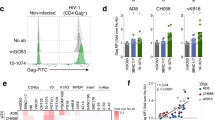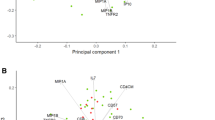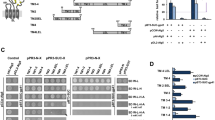Abstract
THE β-chemokine receptor CCR-5 is an essential co-factor for fusion of HIV-1 strains of the non-syncytium-inducing (NSI) phenotype with CD4+ T-cells1–5. The primary binding site for human immunodeficiency virus (HIV)-1 is the CD4 molecule, and the interaction is mediated by the viral surface glycoprotein gp120 (refs 6, 7). The mechanism of CCR-5 function during HIV-1 entry has not been defined, but we have shown previously that its β-chemokine ligands prevent HIV-1 from fusing with the cell1. We therefore investigated whether CCR-5 acts as a second binding site for HIV-1 simultaneously with or subsequent to the interaction between gp120 and CD4. We used a competition assay based on gp120 inhibition of the binding of the CCR-5 ligand, macrophage inflammatory protein (MIP)-1β, to its receptor on activated CD4+ T cells or CCR-5-positive CD4− cells. We conclude that CD4 binding, although not absolutely necessary for the gp120–CCR-5 interaction, greatly increases its efficiency. Neutralizing monoclonal antibodies against several sites on gp120, including the V3 loop and CD4-induced epitopes, inhibited the interaction of gp120 with CCR-5, without affecting gp120–CD4 binding. Interference with HIV-1 binding to one or both of its receptors (CD4 and CCR-5) may be an important mechanism of virus neutralization.
This is a preview of subscription content, access via your institution
Access options
Subscribe to this journal
Receive 51 print issues and online access
$199.00 per year
only $3.90 per issue
Buy this article
- Purchase on Springer Link
- Instant access to full article PDF
Prices may be subject to local taxes which are calculated during checkout
Similar content being viewed by others
References
Dragic, T. et al. Nature 381, 667–673 (1996).
Deng, H. K. et al. Nature 381, 661–666 (1996).
Choe, H. et al. Cell 86, 1135–1148 (1996).
Doranz, B. J. et al. Cell 86, 1149–1159 (1996).
Alkhatib, G. et al. Science 272, 1955–1958 (1996).
Maddon, P. J. et al. Cell 47, 333–348 (1986).
Lasky, L A. et al. Cell 50, 975–985 (1987).
Wells, T. N. C. et al. J. Leuk. Biol. 59, 53–60 (1996).
Samson, M., Labbe, O., Mollereau, C., Vassart, G. & Parmentier, M. Biochemistry 11, 3362–3367 (1996).
Raport, C. J., Gosling, J., Schweickart, V. L., Gray, P. W. & Charo, I. F. J. Biol. Chem. 271, 17161–17166 (1996).
Neote, K., DiGregorio, D., Mak, J. Y., Horuk, R. & Schall, T. J. Cell 72, 415–425 (1993).
Loetscher, P., Seitz, M., Baggiolini, M. & Moser, B. J. Exp. Med. 184, 569–578 (1996).
Paxton, W. A. et al. Nature Med. 2, 412–417 (1996).
Liu, R. et al. Cell 86, 367–378 (1996).
Weissenhorn, W. et al. EMBO J. 15, 1507–1514 (1996).
Healey, D. et al. J. Exp. Med. 172, 1233–1242 (1990).
Allaway, G. P. et al. AIDS Res. Hum. Retrovirus 11, 533–540 (1995).
Moore, J. P. & Ho, D. D. AIDS 9 (suppl. A), S117–S136 (1995).
Moore, J. P., Sattentau, Q. J., Wyatt, R. & Sodroski, J. J. Virol. 68, 469–484 (1994).
Moore, J. P. & Sodroski, J. J. Virol. 70, 1863–1872 (1996).
Cheng-Mayer, C. AIDS 4 (suppl. 1), S49–S56 (1990).
Thali, M. et al. J. Virol. 67, 3978–3988 (1993).
Wyatt, R. et al. J. Virol. 69, 5723–5733 (1995).
Moore, J. P., Yoshiyama, H., Ho, D. D., Robinson, J. E. & Sodroski, J. AIDS Res. Hum. Retroviruses 9, 1179–1187 (1993).
Sullivan, N., Sun, Y., Li, J., Hoffmann, W. & Sodrski, J. J. Virol. 69, 4413–4422 (1995).
Allan, J. S., Strauss, J. & Buck, D. W. Science 247, 1084–1088 (1990).
Burkly, L. C. et al. J. Immunol. 149, 1779–1787 (1992).
Gorny, M. K. et al. J. Virol. 68, 8312–8320 (1994).
White-Scharf, M. E. et al. Virology 192, 197–208 (1993).
Lu, S. et al. J. Virol. 70, 3978–3991 (1996).
Author information
Authors and Affiliations
Rights and permissions
About this article
Cite this article
Trkola, A., Dragic, T., Arthos, J. et al. CD4-dependent, antibody-sensitive interactions between HIV-1 and its co-receptor CCR-5. Nature 384, 184–187 (1996). https://doi.org/10.1038/384184a0
Received:
Accepted:
Issue Date:
DOI: https://doi.org/10.1038/384184a0
This article is cited by
-
Beneficial and Adverse Effects of cART Affect Neurocognitive Function in HIV-1 Infection: Balancing Viral Suppression against Neuronal Stress and Injury
Journal of Neuroimmune Pharmacology (2021)
-
Distinct conformations of the HIV-1 V3 loop crown are targetable for broad neutralization
Nature Communications (2021)
-
The bright and dark sides of protein conformational switches and the unifying forces of infections
Communications Biology (2020)
-
Induction of neutralizing antibodies against tier 2 human immunodeficiency virus 1 in rhesus macaques infected with tier 1B simian/human immunodeficiency virus
Archives of Virology (2019)
-
Evaluation of the contribution of the transmembrane region to the ectodomain conformation of the human immunodeficiency virus (HIV-1) envelope glycoprotein
Virology Journal (2017)
Comments
By submitting a comment you agree to abide by our Terms and Community Guidelines. If you find something abusive or that does not comply with our terms or guidelines please flag it as inappropriate.



